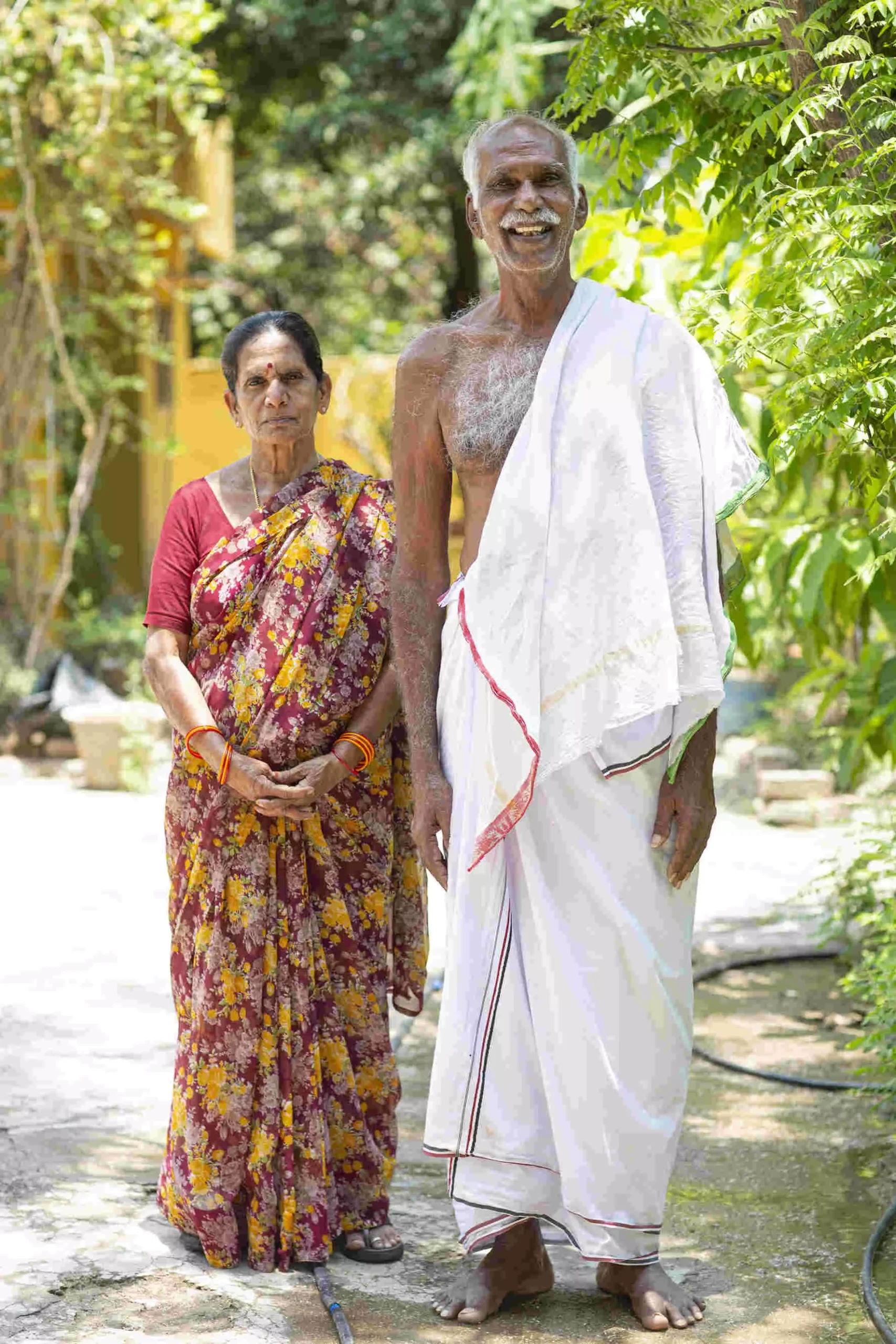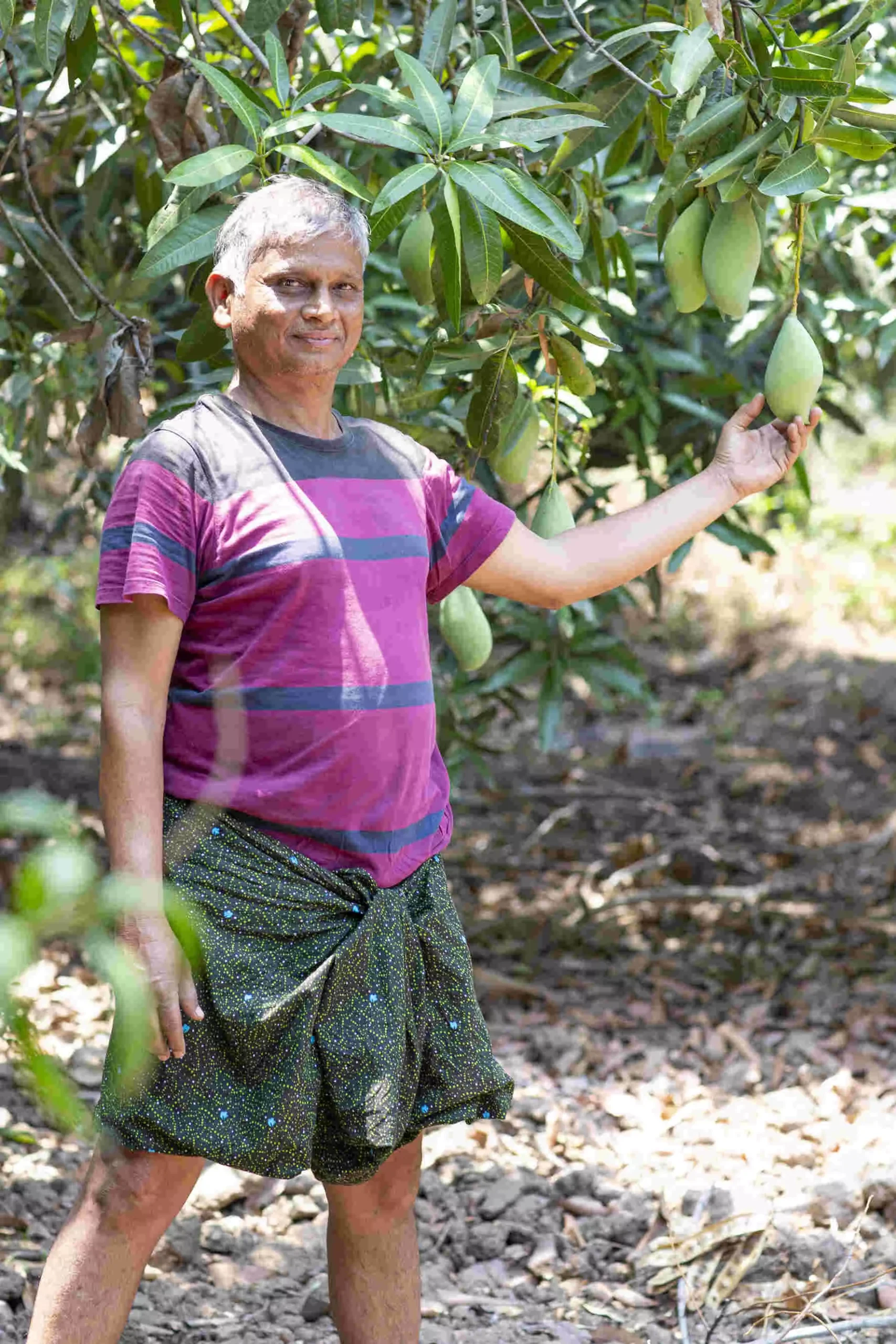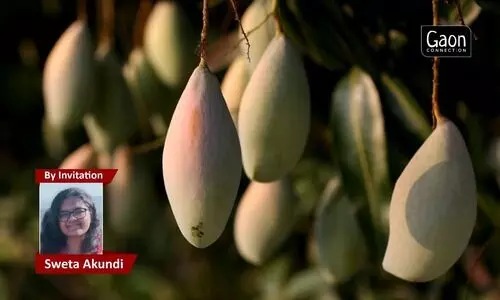Eighty-two-year-old SriRamulu Reddy had a dreamy look on his face as he recalled how he would play with his brothers on the very farm that he is surrounded by now.
“It was a lake near this farm that my father threw us in, to teach us how to swim, and it was on the trees that grew here that the girls would hang swings,” the octogenarian said, seated on a chair in the front porch of his house on the 100-acre farm in Aragonda village of Thavanampalle Mandal in Chittoor district, Andhra Pradesh.
SriRamulu has vivid memories of August 15, 1947. A school in Thavanampalle, announced to its students that from that day forth, India was a free country. SriRamulu, all of seven years, ran into the streets with his older brother and his friends, waving photos of Mahatma Gandhi and Jawaharlal Nehru handed out to them. They ran to their ancestral farm dotted with trees of coconuts, amla, and neem, reminisced the 82-year-old.

At 82, Sri Ramulu takes care of his family’s ancestral farm. He has observed it change farm practices from paddy to mangoes. Pic credits: Raju Patil
Also Read: Mango production in India to be hit due to early arrival of heatwaves
Those trees are now gone and replaced with a mango orchards. In the 1940s, where there grew acres and acres of paddy exposed to sunlight, today, there stand mango trees, their shade giving respite from the dry summer sun.
However, the changing agri landscape of Aragonda village – from paddy to sugarcane to now mango orchards – is also a reminder of how climate change and erratic rainfall patterns are affecting the farming community.
Aragonda in Thavanampalle is today famous for its mangoes. The mandal is in Chittoor district, which, along with Vijayanagaram and Visakhapatnam, is responsible for Andhra Pradesh’s status as the second largest producer of mangoes in India, after Uttar Pradesh.
Banganapalle, Neelam, Imampasand, Totapuri, Kalapadi – trees fruit about eight to 10 varieties here every summer. Each type of mango serves its purpose: the Totapuri is easy to pulp; the Imampasand is the sweetest; and the Naatu Mavadikaya tastes best when pickled.
But much before the yellow mango became Aragonda’s identity, it was the golden jaggery that this village was famous for. Almost every mango farm in Aragonda was once a sugarcane field, which in turn used to be a paddy field. This transformation is but a reflection of how climate change and other factors directly affect what the farmers grow and what we eat.
From paddy to sugarcane to mangoes
“I remember when I was a child, there was a drought that lasted seven years,” said 67-year-old Babu Reddy, who lives with his wife Chittamma in a house painted as yellow as the mangoes he grows on his 10-acre farm. Like many others in Aragonda, he too grew sugarcane before shifting to mangoes.
The drought of the 60s and 70s turned Aragonda to the dry region we know it to be today, he said. While the popular belief in the area seems to be that rainfall levels in Chittoor have been decreasing over the decades, there is scant meteorological data to back it.
A 2020 study by the India Meteorological Department (IMD) on the rainfall variance in Andhra Pradesh analysed 30 years of data from 1989 to 2018. Although the IMD stated that annual rainfall for the state as a whole did not indicate any statistically significant trend, it did find that most stations in all districts of Andhra Pradesh showed an upward trend in the frequency of dry days.
“In any case, the ground water table has been falling,” said Babu Reddy. “Since 1972, we have dug 10 borewells on our lands.”

Babu Reddy with his wife Chittamma. He grows mangoes on his 10-acre farm. Picture credits: Raju Patil
The decline of sugarcane fields is not just a result of the climate, but also the market, pointed out P Chengel Reddy, general secretary of Hyderabad-based Consortium of Indian Farmers Association.
“Chittoor used to be a hub for sugar factories. But since sugar started being procured for the PDS (Public Distribution System), its market price started being controlled, while the price of diesel, pesticides and everything that goes into its production remained the same,” Chengel Reddy said. “Farmers were forced to sell sugar at a low price, leading to low profits. Eventually, by the 2000s, the sugar industry in this district collapsed,” he added.
Crop rotation was more popular when SriRamulu was a child. “In those days, if we grew paddy one year, we would grow sugarcane the next, and ragi the third year. That rotation was good for the soil,” he said.
This rotation is not possible when the farms are dedicated to growing mangoes.
“Growing paddy or ragi needs an open field with lots of sunlight. So even though mangoes are seasonal, you can’t grow anything else with it. The shade from the trees, on different sections of the farm, depending on the time of the day and the angle of the sunlight, would result in an uneven yield,” K Ramesh Kumar, who owns a three-acre mango farm, said.
Mango — the only option
Growing mangoes has become the only option for Aragonda’s farmers. Ramesh looked up at one of the Neelam trees on his farm and observed that it was not drooping as much as a heavily laden tree would by this time of summer. It may be a fate better than a few of his neighbours. He pointed out that the people next door who were still growing paddy have faced a loss of Rs 40,000 in the last two years, primarily because of adverse climate events, like the unseasonal rain and consequent flooding the region saw in November 2021.
Yet, small scale farmers like him are dictated to by the price set by local factories and politicians working together. At the auctions in wholesale markets, Banganapalli sells for Rs 40 a kg and Imampasand for Rs 110.
“Last year, we hoped that the Totapuris would fetch at least Rs 12 per kilo. Agro factories buy Totapuris for their pulp. Along with some politicians, they kept slashing the price every week until it came down to Rs 6 a kilo. It was during harvest season so we couldn’t say or do anything. The other option would have been letting the mangoes fall and rot,” said Ramesh.

K Ramesh Kumar on his 3-acre mango. Last year, he had to sell the totapurmi mangoes for as cheap as Rs 6 per kilo. Picture credits: Raju Patil
Also Read: Heatwaves hit menthol crop; oil production drops by almost 40%
The future of farming in Chittoor
But mangoes also may not be sustainable for the farmer in the long run. The seasonal nature of the fruit means that the labour required is irregular and unskilled. Climate change and falling groundwater impacts crop yield, pushing up farming costs. In fact, farmer suicides due to debt have been reported, with Andhra Pradesh facing the third highest number of farmer suicides, as per the National Crime Records Bureau’s 2020 statistics.
Those with smaller land holdings may not be able to sustain themselves. They may give up farming, and migrate to metropolitan cities like Bengaluru and Chennai, now easier to access with better roads and bridges. Even in the rural areas, with the setting up of small businesses, hospitals, and colleges, there are more lucrative employment options, aside from farming, to earn a living.
SriRamulu, who has seen eight decades of farming wondered aloud: “What will the soil be like in another 10 years? What will we be able to grow then?”
Sweta Akundi is a content writer for Apollo Foundation, where she brings out stories from the villages of Andhra Pradesh and Telangana. Formerly a reporter with The Hindu, she is keen on listening to, and sharing, accounts of the lives of everyday people.




















